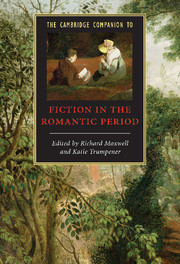Book contents
- Frontmatter
- Introduction
- 1 The historiography of fiction in the Romantic period
- 2 Publishing, authorship, and reading
- 3 Gothic fiction
- 4 The historical novel
- 5 Thinking locally: novelistic worlds in provincial fiction
- 6 Poetry and the novel
- 7 Orientalism and empire
- 8 Intellectual history and political theory
- 9 Women writers and the woman’s novel: the trope of maternal transmission
- 10 Tales for child readers
- 11 Sentimental fiction
- 12 Fiction and the working classes
- 13 The Irish novel 1800-1829
- 14 Scotland and the novel
- Further reading
- Index
- Series List
3 - Gothic fiction
Published online by Cambridge University Press: 28 January 2009
- Frontmatter
- Introduction
- 1 The historiography of fiction in the Romantic period
- 2 Publishing, authorship, and reading
- 3 Gothic fiction
- 4 The historical novel
- 5 Thinking locally: novelistic worlds in provincial fiction
- 6 Poetry and the novel
- 7 Orientalism and empire
- 8 Intellectual history and political theory
- 9 Women writers and the woman’s novel: the trope of maternal transmission
- 10 Tales for child readers
- 11 Sentimental fiction
- 12 Fiction and the working classes
- 13 The Irish novel 1800-1829
- 14 Scotland and the novel
- Further reading
- Index
- Series List
Summary
Gothic fictions of the Romantic period are constructed as curious compounds of the unknown and the too well-known. On the one hand, these narratives traded in obscurity and mystery. This trade (and attendant turn away from the novel of modern life) had gotten underway, vexingly enough, at precisely the historical moment when it looked as if an educated populace, weaned from superstition, schooled in the empiricist protocols of the Scientific Revolution, would at last be ready and able to see the world in its true colors. Gothic fictions reacquainted that populace with the perverse pleasures of uncertainty. Thus, for instance, the preference in many of these books for envisioning landscapes in those atmospheric conditions that Ann Radcliffe, virtuoso of picturesque description, evokes: her heroine admires the vista at times when “the progress of twilight, gradually spreading its tints . . ., steal[s] from the eye every minuter feature of the scene,” or when “long billows of vapour” are seen “excluding the country below, and now opening, and partially revealing its features.” The prospect conjured up in such passages discloses only enough for us to know that mystery is almost literally in the air. The Enlightenment assumption that truth is the product of an unmediated encounter between the eye and its object got sidelined when the novel acquired atmosphere (a word that Romantic-period Britons were already learning to use to identify a text's mood-creating tone, and which we continue to apply to texts that give us the chills).
- Type
- Chapter
- Information
- Publisher: Cambridge University PressPrint publication year: 2008
- 4
- Cited by



